Abstract
The name Vibrio hollisae (synonym = Special Bacteriology group EF-13) is proposed for a new group of 16 strains that occurred in stool cultures of patients with diarrhea. V. hollisae is a small gram-negative rod, which is motile with a single polar flagellum. No lateral or peritrichous flagella were observed, even when it was grown on a solid medium. Sodium chloride is required for growth, so V. hollisae is a halophilic vibrio. Strains were positive (36 degrees C, 24 or 48 h) for oxidase (Kovacs), indole production, nitrate reduction to nitrite, and fermentation of D-glucose (acid, no gas), L-arabinose, D-galactose, and D-mannose. Strains were negative for the following tests often used in enteric bacteriology: lipase (corn oil); deoxyribonuclease; gelatinase; methyl red; Voges-Proskauer; utilization of citrate, acetate, and malonate; L-lysine decarboxylase (Møllers); L-ornithine decarboxylase (Møllers); L-arginine dihydrolase (Møllers); growth in KCN medium; and acid production from D-adonitol, D-arabitol, cellobiose, dulcitol, erythritol, glycerol (25% delayed positive at 7 days), i-(myo)-inositol, lactose, maltose, D-mannitol, melibiose, alpha-methyl-D-glucoside, mucate, raffinose, L-rhamnose, salicin, D-sorbitol, sucrose, trehalose, and D-xylose. None of the strains was motile (semisolid medium) at 36 degrees C at 48 h, but by 7 days 88% were motile. The strains did not grow within 2 days when plated on thiosulfate-citrate-bile salts-sucrose (TCBS) agar or MacConkey agar, but they grew on sheep blood agar and marine agar. By DNA-DNA hybridization (75 degrees C, hydroxyapatite with (32)P), V. hollisae was only 0 to 4% related to 21 named species in Vibrio and Photobacterium. The type strain is designated ATCC 33564, which has a mean guanineplus-cytosine content in DNA of 50 mol%. With the disk diffusion method V. hollisae had relatively large zones of inhibition around penicillin, ampicillin, carbenicillin, cephalothin, colistin, polymyxin B, streptomycin, kanamycin, gentamicin, tetracycline, chloramphenicol, and sulfadiazine. Future studies should focus on the isolation of this new vibrio and its ecology and relationship to human diseases.
Full text
PDF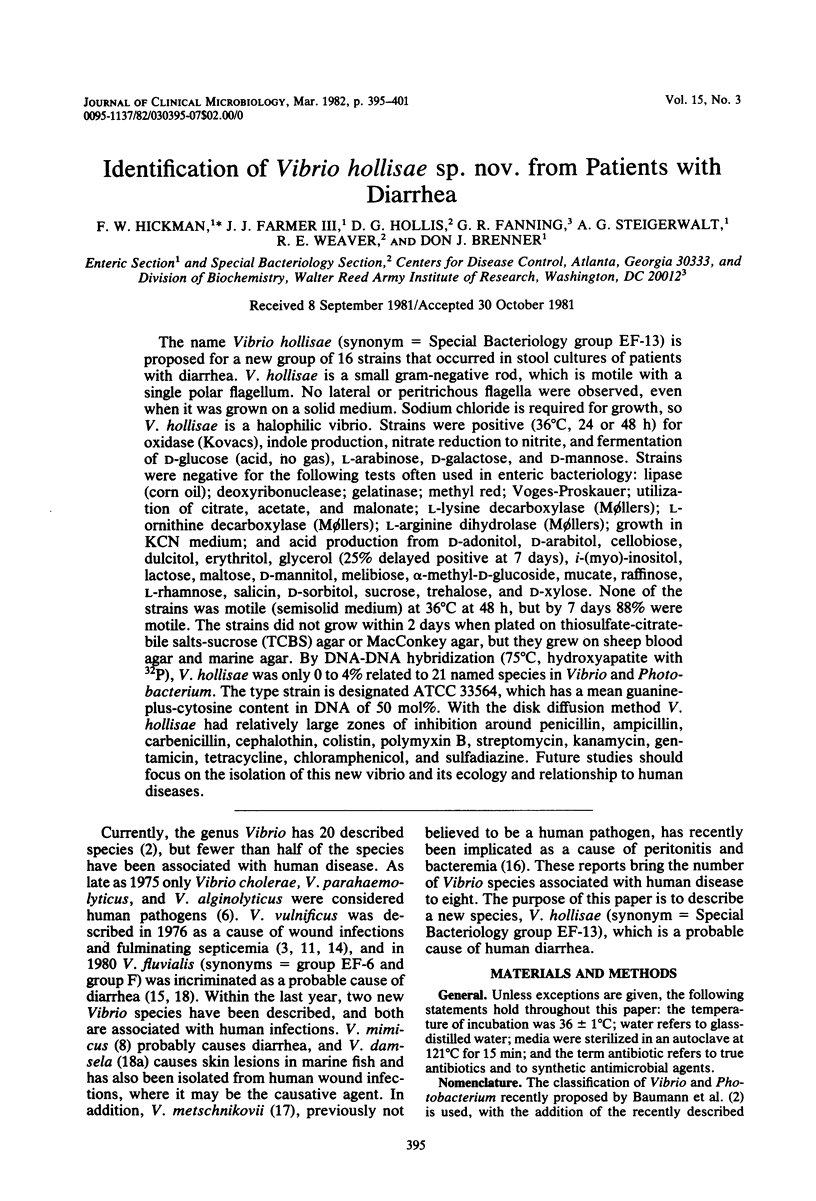
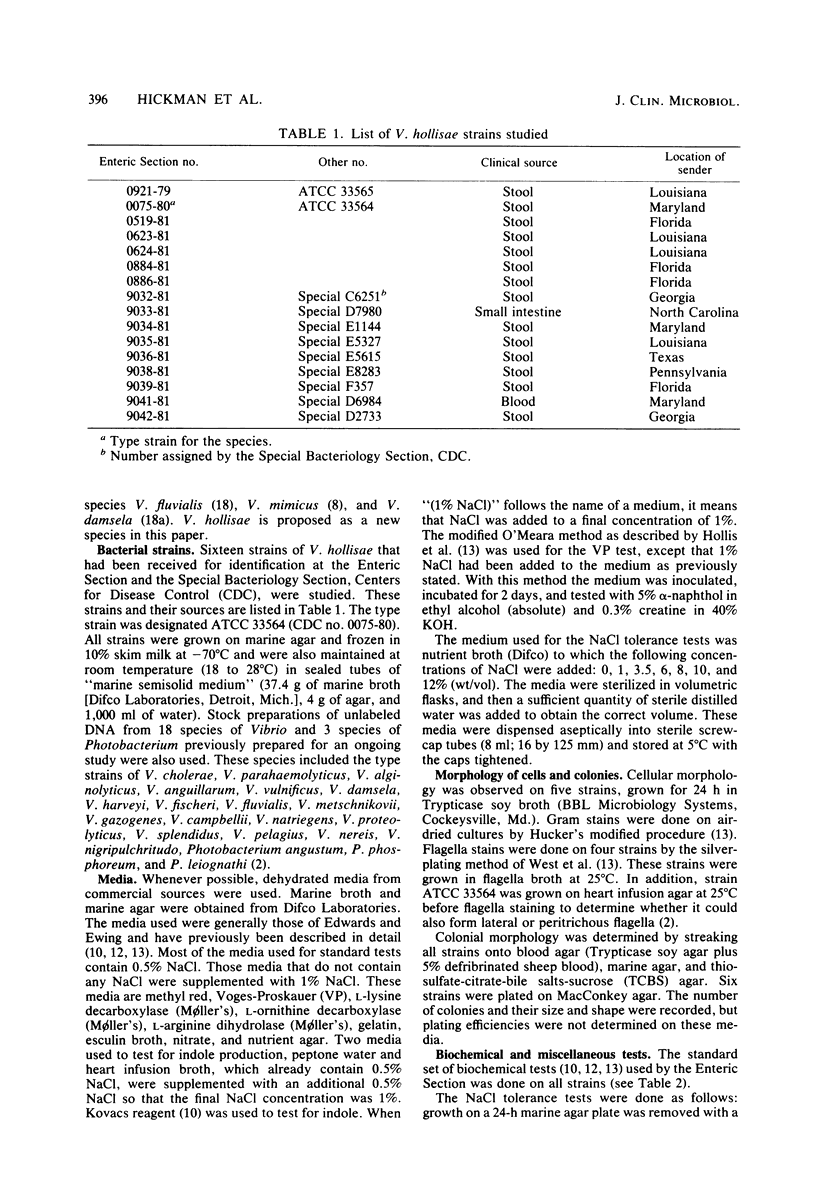

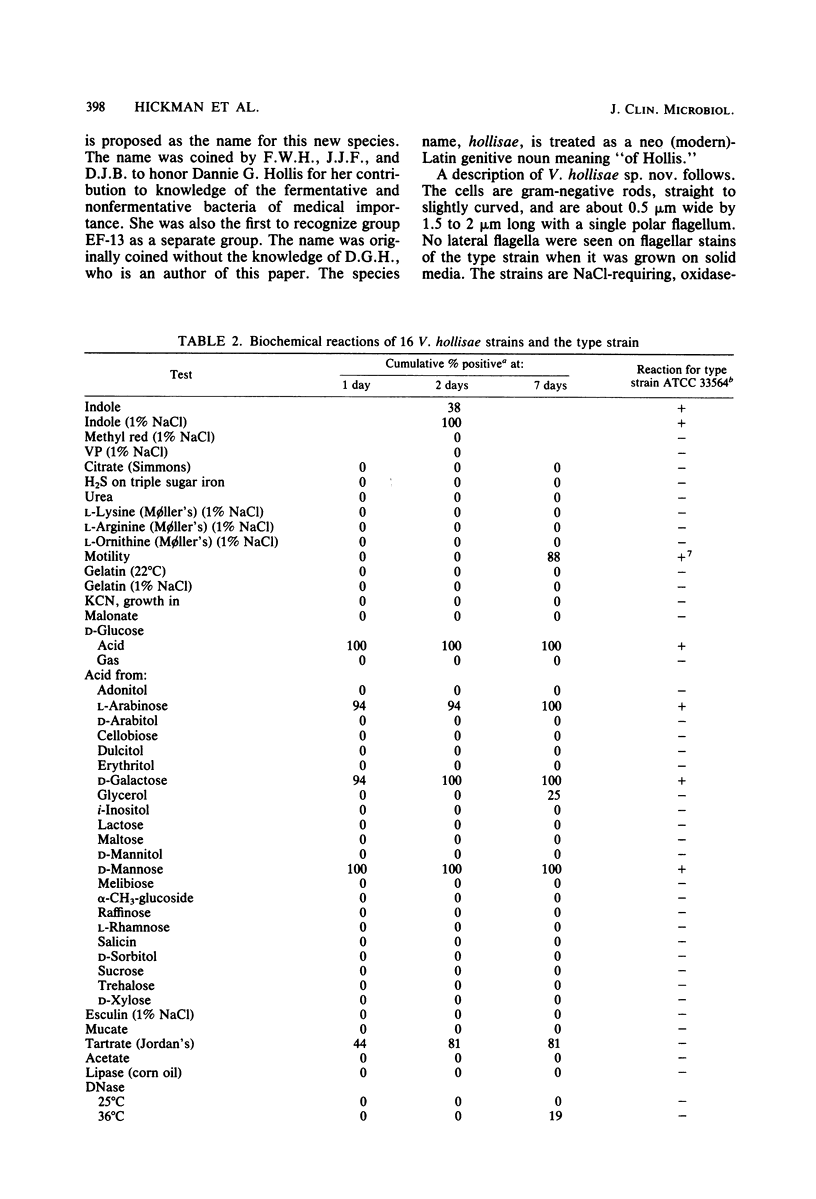
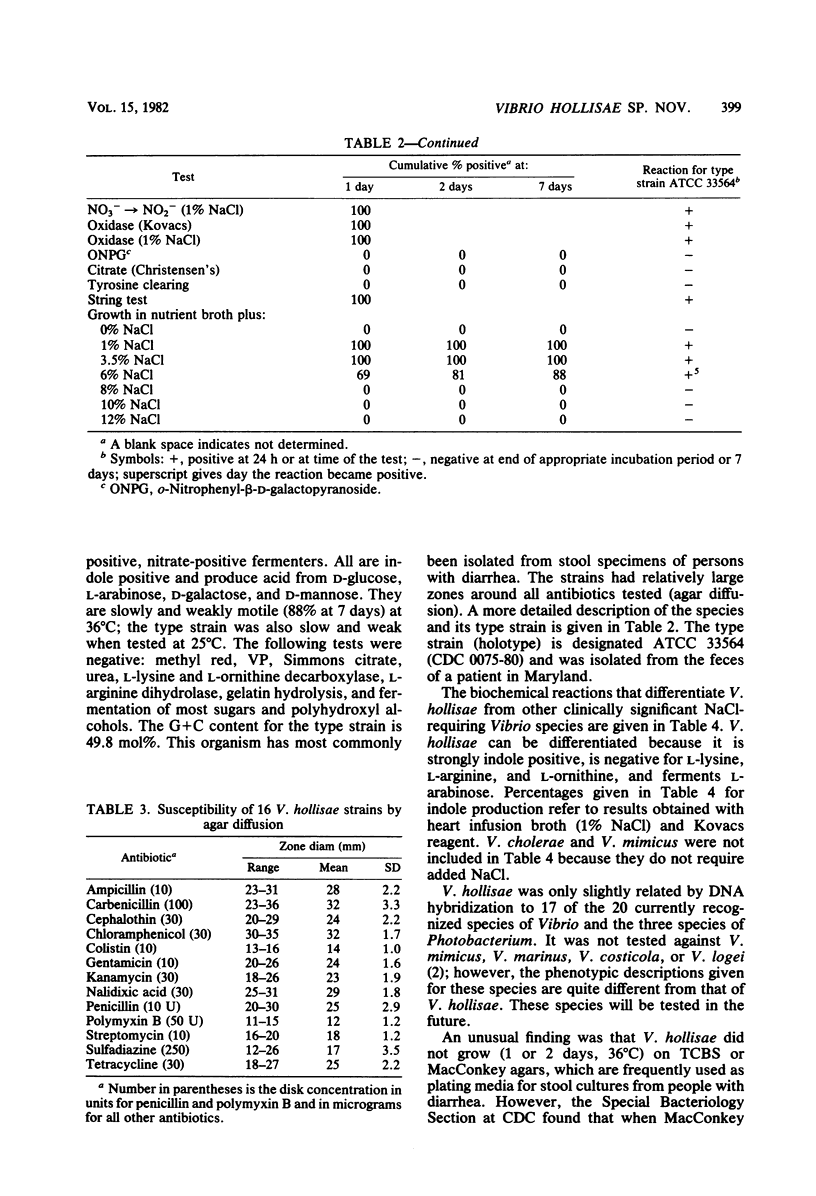
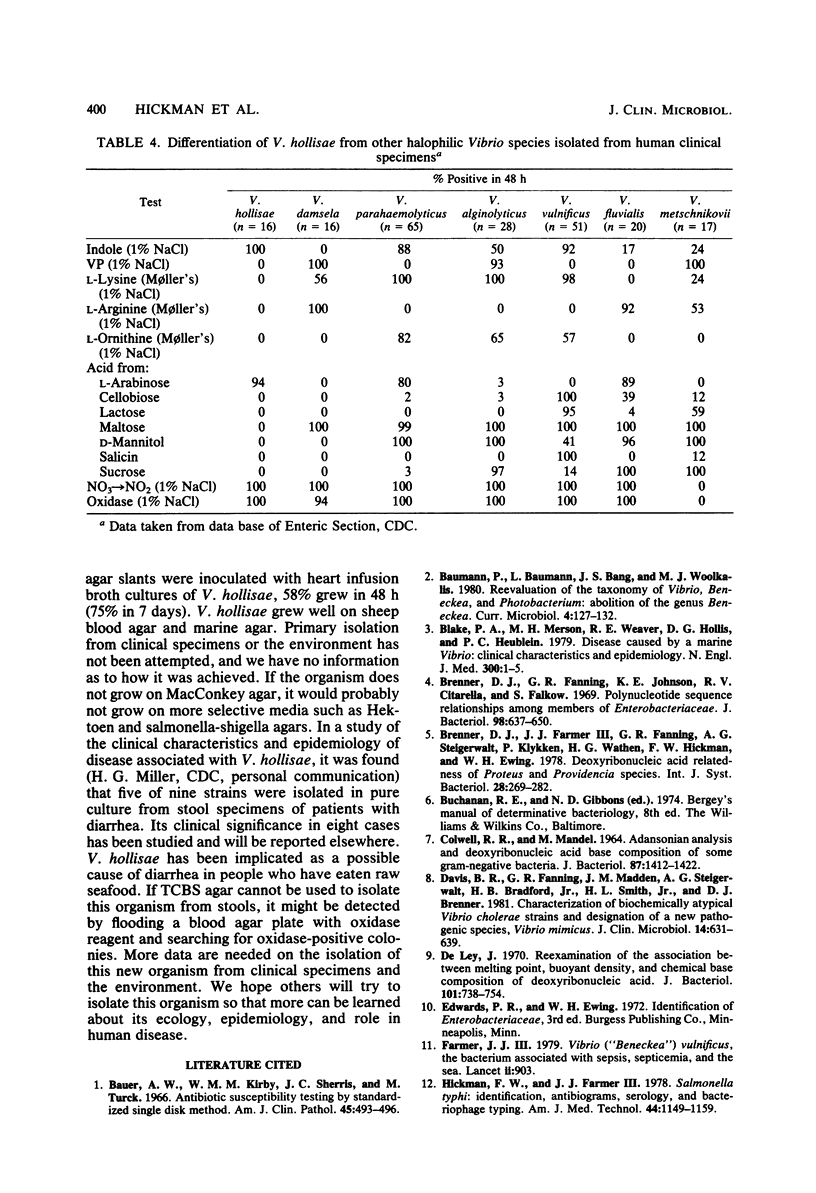
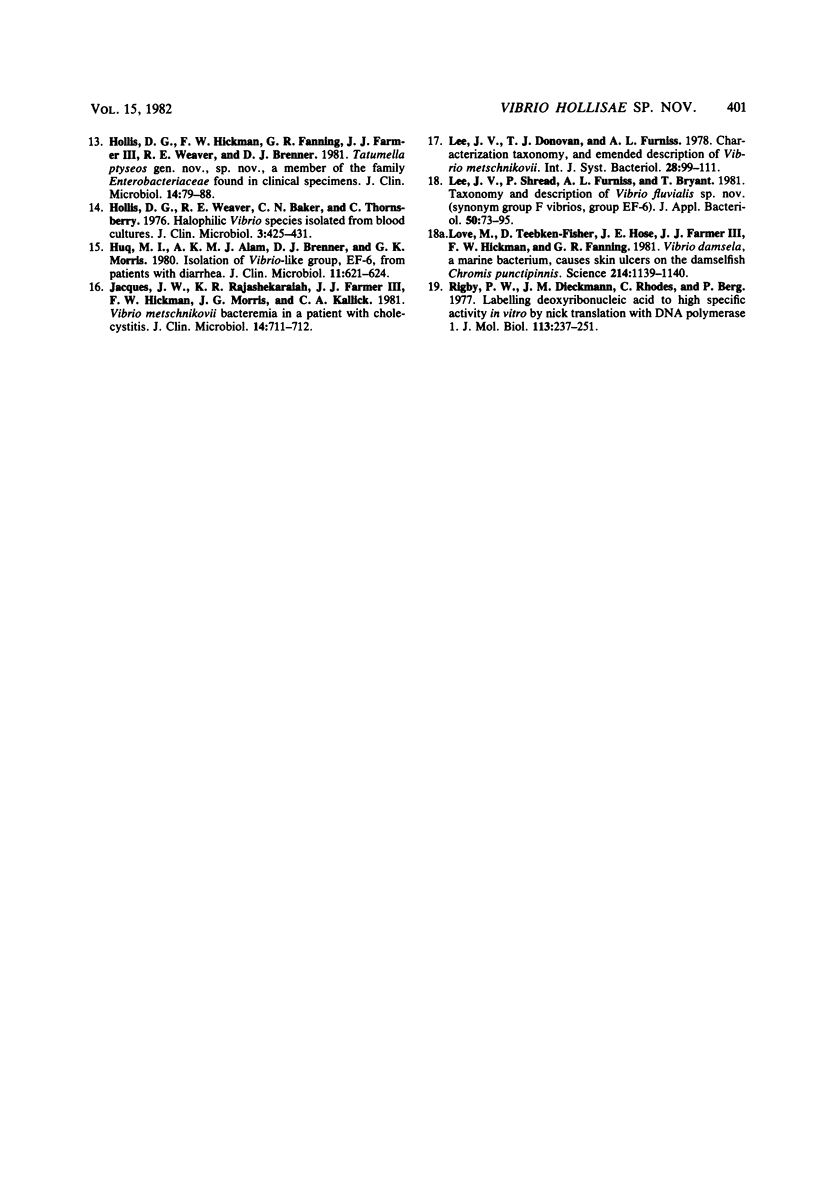
Selected References
These references are in PubMed. This may not be the complete list of references from this article.
- Bauer A. W., Kirby W. M., Sherris J. C., Turck M. Antibiotic susceptibility testing by a standardized single disk method. Am J Clin Pathol. 1966 Apr;45(4):493–496. [PubMed] [Google Scholar]
- Blake P. A., Merson M. H., Weaver R. E., Hollis D. G., Heublein P. C. Disease caused by a marine Vibrio. Clinical characteristics and epidemiology. N Engl J Med. 1979 Jan 4;300(1):1–5. doi: 10.1056/NEJM197901043000101. [DOI] [PubMed] [Google Scholar]
- Brenner D. J., Fanning G. R., Johnson K. E., Citarella R. V., Falkow S. Polynucleotide sequence relationships among members of Enterobacteriaceae. J Bacteriol. 1969 May;98(2):637–650. doi: 10.1128/jb.98.2.637-650.1969. [DOI] [PMC free article] [PubMed] [Google Scholar]
- COLWELL R. R., MANDEL M. ADANSONIAN ANALYSIS AND DEOXYRIBONUCLEIC ACID BASE COMPOSITION OF SOME GRAM-NEGATIVE BACTERIA. J Bacteriol. 1964 Jun;87:1412–1422. doi: 10.1128/jb.87.6.1412-1422.1964. [DOI] [PMC free article] [PubMed] [Google Scholar]
- Davis B. R., Fanning G. R., Madden J. M., Steigerwalt A. G., Bradford H. B., Jr, Smith H. L., Jr, Brenner D. J. Characterization of biochemically atypical Vibrio cholerae strains and designation of a new pathogenic species, Vibrio mimicus. J Clin Microbiol. 1981 Dec;14(6):631–639. doi: 10.1128/jcm.14.6.631-639.1981. [DOI] [PMC free article] [PubMed] [Google Scholar]
- De Ley J. Reexamination of the association between melting point, buoyant density, and chemical base composition of deoxyribonucleic acid. J Bacteriol. 1970 Mar;101(3):738–754. doi: 10.1128/jb.101.3.738-754.1970. [DOI] [PMC free article] [PubMed] [Google Scholar]
- Farmer J. J., 3rd Vibrio ("Beneckea") vulnificus, the bacterium associated with sepsis, septicaemia, and the sea. Lancet. 1979 Oct 27;2(8148):903–903. doi: 10.1016/s0140-6736(79)92715-6. [DOI] [PubMed] [Google Scholar]
- Hickman F. W., Farmer J. J., 3rd Salmonella typhi: identification, antibiograms, serology, and bacteriophage typing. Am J Med Technol. 1978 Dec;44(12):1149–1159. [PubMed] [Google Scholar]
- Hollis D. G., Hickman F. W., Fanning G. R., Farmer J. J., 3rd, Weaver R. E., Brenner D. J. Tatumella ptyseos gen. nov., sp. nov., a member of the family Enterobacteriaceae found in clinical specimens. J Clin Microbiol. 1981 Jul;14(1):79–88. doi: 10.1128/jcm.14.1.79-88.1981. [DOI] [PMC free article] [PubMed] [Google Scholar]
- Hollis D. G., Weaver R. E., Baker C. N., Thornsberry C. Halophilic Vibrio species isolated from blood cultures. J Clin Microbiol. 1976 Apr;3(4):425–431. doi: 10.1128/jcm.3.4.425-431.1976. [DOI] [PMC free article] [PubMed] [Google Scholar]
- Huq M. I., Alam A. K., Brenner D. J., Morris G. K. Isolation of Vibrio-like group, EF-6, from patients with diarrhea. J Clin Microbiol. 1980 Jun;11(6):621–624. doi: 10.1128/jcm.11.6.621-624.1980. [DOI] [PMC free article] [PubMed] [Google Scholar]
- Jean-Jacques W., Rajashekaraiah K. R., Farmer J. J., 3rd, Hickman F. W., Morris J. G., Kallick C. A. Vibrio metschnikovii bacteremia in a patient with cholecystitis. J Clin Microbiol. 1981 Dec;14(6):711–712. doi: 10.1128/jcm.14.6.711-712.1981. [DOI] [PMC free article] [PubMed] [Google Scholar]
- Lee J. V., Shread P., Furniss A. L., Bryant T. N. Taxonomy and description of Vibrio fluvialis sp. nov. (synonym group F vibrios, group EF6). J Appl Bacteriol. 1981 Feb;50(1):73–94. doi: 10.1111/j.1365-2672.1981.tb00873.x. [DOI] [PubMed] [Google Scholar]
- Love M., Teebken-Fisher D., Hose J. E., Farmer J. J., 3rd, Hickman F. W., Fanning G. R. Vibrio damsela, a Marine Bacterium, Causes Skin Ulcers on the Damselfish Chromis punctipinnis. Science. 1981 Dec 4;214(4525):1139–1140. doi: 10.1126/science.214.4525.1139. [DOI] [PubMed] [Google Scholar]
- Rigby P. W., Dieckmann M., Rhodes C., Berg P. Labeling deoxyribonucleic acid to high specific activity in vitro by nick translation with DNA polymerase I. J Mol Biol. 1977 Jun 15;113(1):237–251. doi: 10.1016/0022-2836(77)90052-3. [DOI] [PubMed] [Google Scholar]


